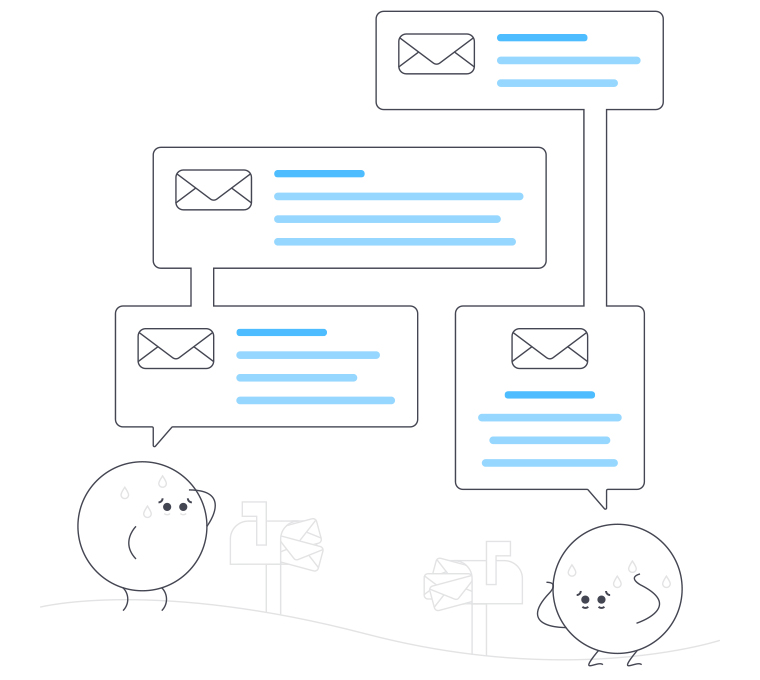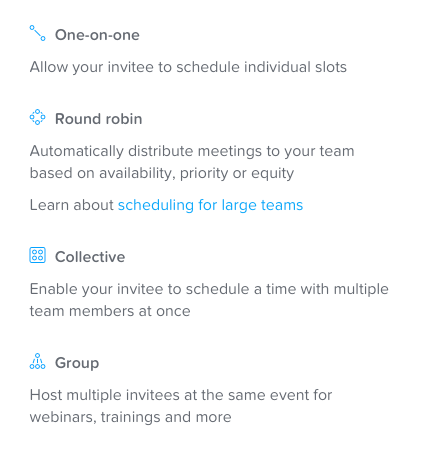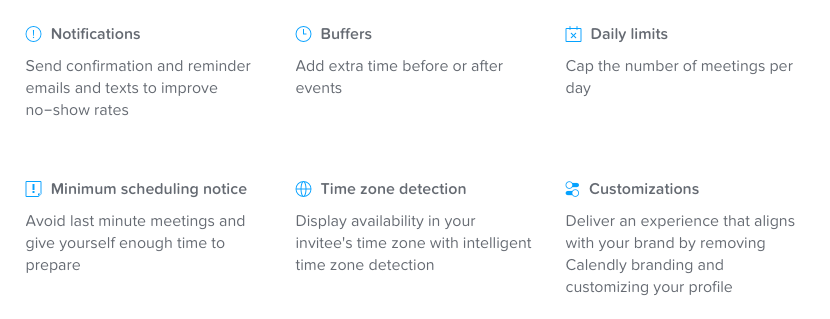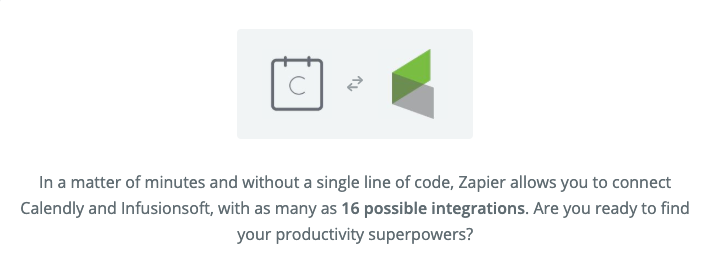There is an undisputable rule in marketing automation: if you have appointments or events to invite contacts to, and manage or negotiate in any way, you are wasting a boatload of time and giving yourself pointless headaches if you’re not using a scheduling tool.
I’d like to highlight one today in particular, namely, Calendly.
What is Calendly?
Calendly is an online scheduling tool that connects with Google Calendar, Outlook, and iCal. It allows you to send meetings or events to any number of individuals so that they can quickly book them.
These meetings and events can be paid or unpaid.
They can also extend to other formats, such as group trainings. One caveat, which I’ll touch on later – Calendly excels for group appointments and small meetings better than much larger shindigs like classes or workshops.
Who should use Calendly?
It’s for any SMB owner needing to eliminate the repetitive task of negotiating meeting times with people. Delegation is key, and any superfluous task that can be done better, automatically, without us having to micromanage it is a huge win.
Parties that are especially well suited to Calendly are consultants who sell their time, because of Calendly’s stripe integration which allows you to sell paid appointments.
It’s also excellent for operations that use sales appointments and sales meetings, considering the tools available for round-robinning (yeah, I made it a verb, whatcha gon’ do?) and fairly sophisticated team distribution. It works well for those who offer classes, workshops or group trainings on a fairly regularized or uniform basis, although Calendly’s scheduling capacities for these is relatively simple in what it provides.
All this said, if you need more advanced features like add-ons or upsells, perhaps Acuity is a more apt choice. This caveat is especially applicable if you need to be using more advanced criteria in the booking of the appointment (as in the case of haircuts or massages or spas) where the type of appointment varies by the kinds of resources or the types of personnel needed to perform particular services.
Again, in these situations, Acuity is probably going to be more in your wheelhouse.
Calendly Benefits
Caveats aside, I love Calendly. It’s an extremely flexible and easy tool to use, which is predicated on how well it does the very specific job it accomplishes. Here are a few key features listed on the Calendly site:
I also love how easy and fast it is – how easy and quick to set up/implement it and connect it to your calendars, along with the intuitiveness of its interface from the user end, along with how *literally* fast it is … I won’t name names, but not all scheduling tools are snappy about loading their calendar availability, which clearly jeopardizes your ability to reliably book appointments.
It looks great on a mobile site, and is extremely flexible for weaving into your funnels.
Here’s an exhaustive list of the Calendly features.
Calendly Drawbacks
One limitation of Calendly is that there is a rather limited number of fields you can request a contact to fill out prior to booking an appointment (I believe it’s three).
I’m not sure what the reason for this is, but if you have sophisticated form requirements, you’ll need to ask them those questions after the appointment has been booked, which isn’t always necessarily a bad thing.
Any other limitations of Calendly are really a “feature-not-a-bug” situation.
Calendly Pricing
As ever, we should probably discuss pricing. So let’s dive in, shall we? Calendly offers three tiers of offerings:
- Basic (which is free)
- Premium (which is $8-10 mo.)
- Pro (which sits at $10-12 mo.)
The Basic option is good if you’re a dabbler by nature or looking to just get a feel for the system. You can use 1 event type, received a personalized calendar link, and can send automated event notifications via email.
Premium steps it up with unlimited event types, poole availability options (such as collective scheduling and round robins), customizable email notifications and reminders, access to metrics and reporting, integration with Zapier (key!) and Zoom and GoToMeeting. If you don’t have paid appointments or use SMS notifications, this is the tier for you.
The Pro tier has some very useful upgrades worth noting. In addition to everything in premium, you can send SMS notifications and reminders, and also sports and integration with Stripe and PayPal (key for processing paid appointments), and also has a google analytics integration that can be useful in certain situations, as well as invitee redirect
You can check out what their various tiers include here.
Connecting Calendly with Keap
Connecting Calendly to Keap (formerly known as Infusionsoft) is pretty painless too. Though it offers a first-party, native integration, it has a few problems and I wouldn’t recommend it, for reasons to wordy for this blog. However, connecting Keap and Calendly through Zapier is a snap, and I recommend it strongly.
Calendly does have some native integrations, but I’ve found some of the direct integrations aren’t as robust as what is available through Zapier.
More on their integration options here.
You can have that zap run on the booking, cancelling, or rescheduling of an appointment, and will work via the “tag app applied” option . One of the beauties of all this is that you only need to use minimal setup between Zapier and Calendly, since Calendly native functionality is already so rich. This may not be the case with ScheduleOnce, Acuity, or … others :/
Editor’s Note: I was reminded by the commenters below that PlusThis also has an integration that connects Calendly and Infusionsoft – so, if you’re already a PlusThis user (or you were thinking about it) then this is another tasty feature that they offer. Details here.
Now I know I’ve painted a pretty glowing picture of Calendly here, but it’s always important to remember that all tools have strengths and weaknesses compared to their competition.
As I’ve mentioned Calendly’s strengths are legion: The pricing is really in that sweet spot, the speed and simplicity of setup is really my favorite feature of all, and it’s flexibility in accommodating different offering types and setups, and if you’re looking to use a scheduling tool in your processes Calendly is among the easiest.
As far as weaknesses go, it’s primary chink-in-the-armor is that it’s not as feature-rich as some even more robust tools like Acuity, and if you’re seeking something that is more along the lines of a facilities management kind of tool, a solution like Acuity or ScheduleOnce is going to be more adequate for you.
Editor’s note: More on integrating Acuity with Infusionsoft in this post.
But if you find yourself in a space that doesn’t have paid appointments, Calendly earns my vote, for sure.
Bonus Tips:
Gmail Templates
If you use Calendly and Gmail, I’d recommend setting up a template that you can use to inject your calendar links into your emails when you’re interacting with people through your normal inbox channel – it can save you time by preventing the need to look it up and copy/paste, etc.
Prefill Calendly Links
You can use merge fields to append information to the calendly link which saves the prospect from having to re-enter information you’ve already collected.
Chrome Plugin
There is a Calendly Chrome Plugin that allows you to quickly grab your links and adjust your availability on the fly. Check it out.










If you have PlusThis we have an integration with Calendly too.
Of course, haha. I’m not a Calendly user myself, so that one wasn’t on my radar – but thanks. For anyone else, there IS a Calendly integration through PlusThis.
You can connect Calendly to Infusionsoft via PlusThis too
Nice call! I forgot about that – here’s the details on the PlusThis Calendly integration.
Is there a way to have a list per contact in Calendly? So for instance when I’m selling a coaching package with 5 calls, can I see in Calendly how many calls the person already had? I’m using Acuity for that reason now, but most of my clients (which are coaches that sell coaching packages) are using Calendly.